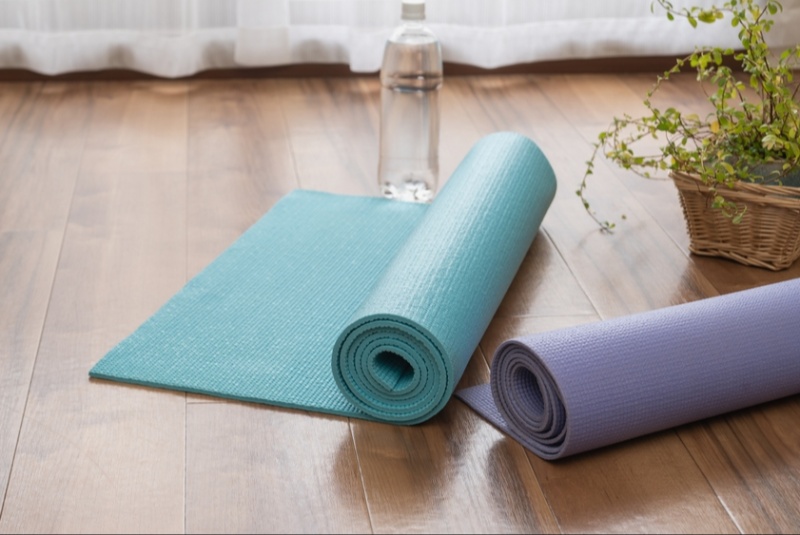A high-quality yoga mat is an essential tool for practicing yoga, providing the foundation for comfort, stability, and safety during your sessions. With a vast array of options available, selecting the best yoga mat can be overwhelming. This guide will help you navigate the different factors to consider, ensuring you find a mat that meets your needs and enhances your yoga practice.
Assessing Your Yoga Practice Needs
Before choosing a yoga mat, it’s crucial to assess your specific practice needs. Consider the type of yoga you practice, the frequency of your sessions, and your environment. For example, hot yoga requires a mat with excellent grip and sweat absorption, while restorative yoga may benefit from a thicker, more cushioned mat. Understanding your practice needs helps narrow down the options and ensures you select a mat that supports and enhances your yoga experience.
Considering Mat Thickness and Cushioning
The thickness of a yoga mat significantly impacts comfort and stability. Mats typically range from 1/16 inch to 1/4 inch in thickness. Thinner mats, around 1/16 inch (1.5mm), offer a firm surface and better stability for balancing poses, making them ideal for travel due to their lightweight and compact nature. Thicker mats, around 1/4 inch (6mm), provide more cushioning, which is beneficial for joint protection during floor exercises and longer sessions. Consider your comfort preferences and any joint issues when selecting the right thickness for your mat.
Evaluating Material and Durability
Yoga mats are made from various materials, each offering different benefits in terms of durability, grip, and eco-friendliness. Common materials include PVC, TPE, natural rubber, and cork. PVC mats are durable and provide excellent grip, but they are not eco-friendly. TPE (thermoplastic elastomer) is a more environmentally friendly option, offering good durability and grip. Natural rubber mats provide excellent traction and are biodegradable but can be heavier. Cork mats are sustainable and naturally antimicrobial, offering a unique texture and grip. Assessing the material helps you choose a durable mat that aligns with your environmental values and grip needs.
Grip and Traction
Grip and traction are critical for maintaining stability and preventing slips during your practice. Look for mats with a textured surface that enhances grip, especially if you practice hot yoga or tend to sweat a lot. Some mats feature a dual-sided design, with one side offering a non-slip surface for added stability. Testing the grip in various conditions, if possible, helps ensure the mat provides reliable traction throughout your practice, promoting safety and confidence in your poses.
Portability and Weight
Portability is an important factor if you travel frequently or attend classes outside your home. Lightweight mats are easier to carry and transport, making them ideal for yogis on the go. Travel mats are usually thinner and can be folded or rolled compactly. However, they may sacrifice some cushioning for portability. Consider the weight and ease of carrying the mat, especially if you need to transport it regularly. A mat that balances comfort and portability ensures you can maintain your practice wherever you go.

Eco-Friendliness and Sustainability
For environmentally conscious yogis, the eco-friendliness of a yoga mat is a significant consideration. Look for mats made from sustainable materials such as natural rubber, cork, or TPE, which have less environmental impact compared to PVC. Brands that use non-toxic, biodegradable materials and eco-friendly manufacturing processes often highlight these attributes. Choosing an eco-friendly mat supports sustainable practices and aligns with the principles of yoga, promoting harmony with nature and ethical consumerism.
Cleaning and Maintenance
Regular cleaning and maintenance are essential for maintaining hygiene and extending the lifespan of your yoga mat. Some mats are machine washable, while others require hand cleaning with a mild detergent and water. Consider mats with antimicrobial properties or those that are easy to wipe down after each use. Regular cleaning helps prevent the buildup of sweat, dirt, and bacteria, ensuring a clean and safe practice environment. Choose a mat that aligns with your cleaning preferences and maintenance routine.
Size and Dimensions
Standard yoga mats are usually 68 inches long and 24 inches wide, but mats are available in various lengths and widths to accommodate different body sizes and practice needs. Taller individuals may benefit from longer mats, around 72 inches or more, to ensure full-body support during poses. Wider mats provide additional space for movements and transitions. Consider your height and the space required for your practice when selecting the size of your mat. A mat that fits your body and practice style enhances comfort and freedom of movement.
Price and Value
Yoga mats come in a wide range of prices, from budget-friendly options to high-end models. While it’s tempting to choose the cheapest option, investing in a high-quality mat can offer better durability, comfort, and performance. Consider the long-term value and how the mat meets your specific needs. Reading reviews and comparing features can help you find a mat that offers the best balance of quality and cost. A well-chosen mat provides a better practice experience and can save money in the long run by reducing the need for frequent replacements.
Testing Before Buying
If possible, test different yoga mats in person before making a purchase. Many yoga studios and retail stores offer mats for you to try out. Pay attention to the mat’s grip, cushioning, and overall feel under your hands and feet. Testing the mat in various poses and movements helps you determine its suitability for your practice. If in-person testing isn’t an option, look for retailers with good return policies, allowing you to try the mat at home and return it if it doesn’t meet your expectations.
Selecting the best yoga mat involves careful consideration of various factors, from thickness and material to grip and eco-friendliness. By understanding your specific practice needs and evaluating different options, you can find a mat that enhances your comfort, stability, and overall yoga experience. Whether you are a beginner or an experienced yogi, investing in a high-quality mat that aligns with your values and preferences ensures a supportive and enjoyable practice. Embrace the journey of finding the perfect mat and enjoy the benefits it brings to your yoga sessions.




